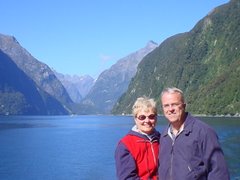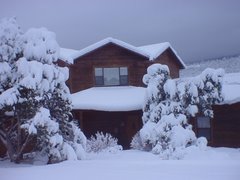I've always had some interest in visiting Israel - several friends have told us about their trips - but not a burning desire. I admire what Israel has been able to accomplish in a very hostile environment and I think it is right for the United States to support them strongly. This opportunity through the American Statistical Association (ASA) offered a chance to see one aspect of Israel that a more conventional tour would not, so that's why I signed up.
From the P2P website I learned it's all about world peace. The program was started by President Eisenhower in 1956. He was "acting on his firm belief that direct interaction between ordinary citizens around the world can promote cultural understanding and world peace."
Statistically speaking, my credo is that better lives all over the world can come from better data and better data-understanding, so that's my angle on the greater cause that we were serving on this trip: World peace through better statistics. Let's give it a try.
Here's how the ASA announced this trip:
People to People Citizen Ambassador Programs and the ASA have created an exchange to foster international goodwill, professional development, and personal enrichment. Join colleagues from around the world who understand the need for greater depth of knowledge in statistical science. Professional experience at any level will make an important contribution to the team. Delegates will learn about statistical literacy efforts in Israel; how statisticians are trained; and the roles of statisticians in health-related professions, industry, and government.
And that's what we did. Time will tell how much it contributed to world peace (I'm being flippant). To be serious, though, for the sake of "cultural understanding," I wish in hindsight that our trip would have included a chance to visit with Muslim/Palestinian/Arab statisticians who work and study in Israel.
Back to the tour. From Tel Aviv we drove north along the coast to Haifa, through a tunnel through a mountain that Haifa straddles, then a little further up the coast to the ancient seaport of Akko, also known as Acre. Irit wanted us to see an underground prison that was constructed during the Crusader occupation - around 1100. There was a lot of road traffic in the area associated with an Arab holiday, so it was slow going and we didn't get to the prison site until almost dark. An attendant at the entrance said, Sorry, closed. Irit pleaded our case and he finally relented and let us in briefly. We couldn't enter the underground area, but could go as far as an overlook. The British built a prison here after they took over this area in 1917 and it was later found to be built atop Crusader-era ruins. Here's the British prison walls.
The next morning we first visited Technion University, the Israel Technical Institute. This is quite a prestigious university and, in fact, a Nobel Prize winner this year in Chemistry is on the Technion faculty. (It later came up in our conversations that the per capita rate of Nobel winners in Israel is quite a bit higher than that of the United States.) Here's a picture of the building where we met.
We met with one of the great lady pioneers in the field of statistics, Ayala Cohen, Director of the Technion Statistical Laboratory.
The faculty member seated between Ayala and Nancy told us quite a bit about his work on short turn-around analyses of very large amounts of data, an example being the wait times of callers to a call center. Variables such as wait time are important measures of how well a center processes its calls. One tidbit of information that was revealed was that in slow times at one center, one operator in the center will call another. Operators’ pay depends on the call volume they handle.
Next we went to see the Baha'i Gardens, situated on a mountain overlooking the Haifa harbor.
Here's a website view of the Gardens.
I knew nothing about the Baha'i Faith, so here's some information, gleaned from the Wikipedia site and what our guide, Irit, told us. It is a monotheistic religion, originating in 19th century Persia, with a basic theme of unity - of people, of religions, ..., of everything . It encompasses "divine messengers" who have appeared over time such as Moses, Abraham, Jesus, Mohammed, and Buddha. According to Wikipedia, the Baha'i Faith has about five to six million followers, spread over some 200 countries. Haifa is an important center because the Faith's founder's tomb is located in these gardens.
We could only enter the top couple of levels, out of 19, of the gardens. Here are a couple of my shots from there.
I read in a newspaper that the Queen Elizabeth cruise ship had been moored in this harbor over the weekend.
From Haifa, we journeyed (in our eight-person van - I don't think I had mentioned) about 150 miles to Jerusalem,by way of the Jordan Valley and West Bank. Our primary cultural stop along the way was Bet She'arim, an ancient Jewish cemetery. Hundreds of people, including important Jewish leaders, were buried in sarcophagi (cement boxes) in caves excavated in hillsides at this site over the period, 200-400 AD.
Here's a website view of the Gardens.
I knew nothing about the Baha'i Faith, so here's some information, gleaned from the Wikipedia site and what our guide, Irit, told us. It is a monotheistic religion, originating in 19th century Persia, with a basic theme of unity - of people, of religions, ..., of everything . It encompasses "divine messengers" who have appeared over time such as Moses, Abraham, Jesus, Mohammed, and Buddha. According to Wikipedia, the Baha'i Faith has about five to six million followers, spread over some 200 countries. Haifa is an important center because the Faith's founder's tomb is located in these gardens.
We could only enter the top couple of levels, out of 19, of the gardens. Here are a couple of my shots from there.
I read in a newspaper that the Queen Elizabeth cruise ship had been moored in this harbor over the weekend.
From Haifa, we journeyed (in our eight-person van - I don't think I had mentioned) about 150 miles to Jerusalem,by way of the Jordan Valley and West Bank. Our primary cultural stop along the way was Bet She'arim, an ancient Jewish cemetery. Hundreds of people, including important Jewish leaders, were buried in sarcophagi (cement boxes) in caves excavated in hillsides at this site over the period, 200-400 AD.
Here's the entrance to one section.
And here is a chamber.
No bones left behind. Great place for a Halloween Haunted House.
Here are some examples of decorated sarcophagi (sarcophaguses?).
And here’s a (candid) picture of Irit in lecture-mode.
She had a lot of enthusiasm that added to her presentations: “Here, my dear friends,” she would say, sometimes going airborne, “we’re going to see the most amazing thing.” She’s been doing guide work for 16 years. She works as a free-lancer, guiding small to medium sized groups around the country, tailoring the itinerary to a group’s interests and time.
We next drove through the Jezreel Valley, a large farming valley south of the Sea of Galilee, the farms being owned and operated by kibbutzes, not individuals.
Then we drove through the West Bank region and on to Jerusalem. I don't understand and would not try to explain all the border and other issues pertaining to the West Bank, but there was a grim feeling driving through the area. Topographically, much of the area resembled barren area of New Mexico, such as the Jornado del Muerto (Journey of Death) along the Rio Grande in south-central NM. The mood was lightened somewhat by the occasional Bedouin camps and accompanying camels.
We got to the Mount of Olives just about sunset. Here's a little girl enjoying a camel ride.
The hillsides of the Mount of Olives are covered by a large cemetery.
Bodies are buried in the ground beneath these cement boxes, not sealed in them.
Looking across the way, into the setting sun,you can see the walled city of Old Jerusalem, backed by modern Jerusalem.
We would spend Thursday in the old city.
A Sanctuary of Gethsemane on the Mount of Olives commemorates the site where Jesus prayed before being arrested, taken away, and crucified.
Then we drove through the West Bank region and on to Jerusalem. I don't understand and would not try to explain all the border and other issues pertaining to the West Bank, but there was a grim feeling driving through the area. Topographically, much of the area resembled barren area of New Mexico, such as the Jornado del Muerto (Journey of Death) along the Rio Grande in south-central NM. The mood was lightened somewhat by the occasional Bedouin camps and accompanying camels.
We got to the Mount of Olives just about sunset. Here's a little girl enjoying a camel ride.
The hillsides of the Mount of Olives are covered by a large cemetery.
Bodies are buried in the ground beneath these cement boxes, not sealed in them.
Looking across the way, into the setting sun,you can see the walled city of Old Jerusalem, backed by modern Jerusalem.
We would spend Thursday in the old city.
A Sanctuary of Gethsemane on the Mount of Olives commemorates the site where Jesus prayed before being arrested, taken away, and crucified.
So, that was our introduction to Jerusalem. Two more days there: next posting.
Rob





















No comments:
Post a Comment